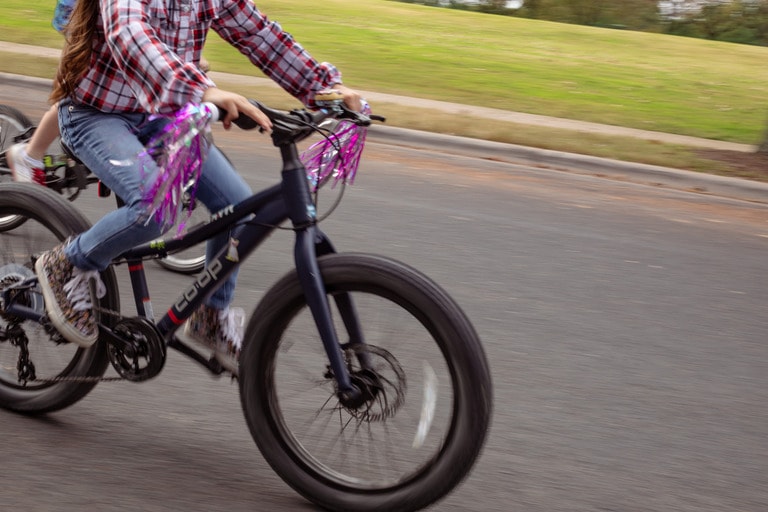Buying a bike for a growing child is trickier than simply remembering which color is their favorite. How do you know when they're ready to graduate to a bigger bike? When are they ready to use hand brakes or gears? But fear not, we'll guide you through the process of knowing when it's time to upsize your child's bike.
And because kids often outgrow their bikes fast, often in a few years, keeping pace with new wheels can get pricey. Luckily, you have options beyond buying new, like searching for used bikes or checking out bike trade-in and trade-up programs offered by some retailers or bike shops. Also, try connecting with parents of older kids at your school or in your neighborhood to set up your own informal bike exchange.
How do I find the right size bike for my child? For an in-depth guide to choosing a kid's bike, including a kids' bike sizing chart, we recommend you read How to Choose Kids' Bike. This article will cover how to tell when your child has outgrown a bike, and what other factors to consider when upsizing.
Clues Your Child Is Ready for a Bigger Bike
Your child needs to size up to a larger ride when they max out the height of the seatpost or if they become too cramped in the cockpit or hunched over while pedaling.
Here's how to tell if your child is outgrowing their bike:
The child is cramped while pedaling. Observe at your child's body position when they ride their bike. If you notice that the child's knees come close to their handlebars or chest at the top of their pedal stroke or if their knees impede their ability to make turns, the bike is too small. Also, their elbows should only be at a slight bend.
The child maxes out the height of the seatpost. Bike seatposts can typically be adjusted higher or lower in the seat tube to fit a rider. That flexibility allows you to use the bike longer as the child grows. But if that seatpost reaches its maximum height for safe riding and the child isn't comfortable or is too cramped while riding, it's time to consider a larger bike. The bike's seatpost should have a "minimum insertion" or "maximum extension" line on it. For safe riding, the seatpost should be inserted far enough so that line isn't visible.
Ideally, when your child's foot is at the bottom of the pedal stroke there will be a slight bend in the leg (about 80% to 90% of full leg extension). If your child's leg is bent more than that, or if they can stand flat-footed on the ground and still needs the saddle raised higher than that line, then it's time for a bigger bike. (Read more about bike fitting here.)
Should I buy a bike that a kid can "grow into"? While it's tempting to save some money and buy a size that your child can "grow into." Avoid doing it. A bike that's too big will be difficult for your young rider to maneuver, because of its size, weight or reach. If the bike is too small or too large for the child, they may lose control and fall. Children on properly sized bikes are more likely to enjoy the experience. That, in turn, can foster a lifelong love of cycling.
Other Factors to Consider

While your child's height and the corresponding bike size will be the biggest factors in your decision to get a bigger bike, don't forget other factors such as brakes, gears and suspension. Consider your child's riding experience, comfort and confidence levels. Whenever possible, avoid introducing multiple new bike features at the same time. It's a lot to learn! For example, if you're introducing your child to hand-braking, consider waiting until their next bike to introduce gearing.
Brakes
The smallest rides, like 12-inch bikes, often don't have brakes. (Children's bikes are based on the diameter of the wheel.) Brakes often come into play with bikes with 16-inch wheels, and you'll generally find coaster brakes (or footbrakes) in many kids' bikes, a U.S. bicycle requirement.
Coaster brakes engage the brake (on the rear wheel) when the child pedals backward. Hand brakes offer more control and stopping power than coaster brakes, so you'll know it's time to move to a hand brake system once your child begins riding at faster speeds and needs the ability to stop quickly and effectively. Some kids skip coaster brakes altogether and move directly from a brake-free bike to hand brakes.
Hand brakes require more dexterity, so it's important to make sure your child has both the hand size and strength to comfortably squeeze the brake. Remember that there's likely to be a learning curve with this step. Your child might not immediately feel competent using the hand brake, but if they are able to reach the brake and are comfortable with balance (especially without training wheels), steering, and pedaling, then they are probably ready to take their next step. If possible, bring your child in for a test ride, so that a skilled bike tech can gauge their ability to handle the brakes. The expert can also make any necessary adjustments to the placement of the hand brake levers to ensure they're properly placed for your child's hands.
Gears
Gearing is often introduced starting at 20-inch bikes and bigger.
Single-speed bikes have only one gear. They're great for kids still working to master their balance, steering, pedaling and hand-braking, especially since younger kids tend to spend most of their time riding on relatively flat terrain.
Geared bikes allow kids to successfully navigate a wider range of speeds and terrain, especially hills. They also make it easier to conserve energy, allowing the rider to go longer distances. Gears take time to get used to, however. Introduce them once your child is old enough to understand how they work, mainly that they must be pedaling to engage the gears and that they should shift before hitting an incline. Find more tips in How to Use Gears.
Suspension
Suspension is often an option in 24-inch bikes, as well as some 20-inch bikes, though kids may not need suspension until they start riding an adult-sized 26-inch bike or larger.
Suspension-free bikes are the norm for most kids' bikes (and even mountain bikes made for kids) for two reasons: Most children aren't heavy enough to engage the suspension, nor are they riding the off-road terrain that demands it. Rather, these bikes use work-arounds like wider tires, which provide a similar dampening effect without adding the weight of a true suspension fork.
Suspension bikes, which help to insulate the rider from the roughness of a trail ride, are incredible tools once your child begins riding over rocks, roots, and off-camber terrain. Make sure that they weigh enough, and are strong enough, to engage the suspension (often around age 12).

